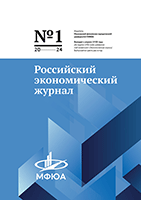Архив
Российский экономический журнал 2 / 2023
Государственная политика развития экономики мягкой силы
Побываев С.А., Сильвестров С.Н.
Российский экономический журнал. 2023. № 2. С. 95–108.
Russian Economic Journal. 2023;(2): 95–108.
Научная статья
УДК 330.3
https://doi.org/10.52210/0130-9757_2023_2_95
ГОСУДАРСТВЕННАЯ ПОЛИТИКА РАЗВИТИЯ ЭКОНОМИКИ МЯГКОЙ СИЛЫ1
Сергей Алексеевич Побываев,
Финансовый университет при Правительстве Российской Федерации, Москва, Россия
sergeypob@mail.ru http://orcid.org/0000-0002-7312-7059
Сергей Николаевич Сильвестров,
Финансовый университет при Правительстве Российской Федерации, Москва, Россия
fm.fa@yandex.ru
Аннотация. В предлагаемом материале рассматривается экономический источник так называемой мягкой силы государства — креативную экономику. Тема представляется весьма актуальной, поскольку развитие креативной экономики создает и укрепляет внутренний и международный имидж страны. Приведена структура креативной экономики, а также рассмотрены общемировые тенденции развития креативной экономики и креативных индустрий, равно как и закономерности государственной регулятивной деятельности в этой сфере. Кроме того, рассмотрены страновые особенности развития креативных индустрий в таких странах, как Великобритания, США, Германия, Австралия и Россия. В отношении отечественного опыта проанализированы позитивные и проблемные точки развития креативной экономики. На основании этого сделаны выводы о том, что:
— креативная экономика становится все более коммерческой отраслью, но весьма специфической и нуждающейся в особых методах регулирования и стимулирования;
— ближайшей неотложной задачей развития креативной экономики России является правовое урегулирования этой области;
— также к числу важнейших задач в сфере развития креативной экономики является создание отечественных цифровых платформ большой мощности.
Ключевые слова: мягкая сила, государственная политика, креативная экономика, креативные индустрии, малое предпринимательство, цифровая платформа, законодательное регулирование
Для цитирования: Побываев С.А., Сильвестров С.Н. Государственная политика развития экономики мягкой силы // Российский экономический журнал. 2023. № 2. С. 95–108. https://doi.org/10.52210/0130-9757_2023_2_95
Original article
PUBLIC POLICY OF SOFT POWER ECONOMY DEVELOPMENT
Sergey A. Pobyvaev,
Financial University under the Government of the Russian Federation, Moscow, Russia
sergeypob@mail.ru http://orcid.org/0000-0002-7312-7059
Sergey N. Silvestrov,
Financial University under the Government of the Russian Federation, Moscow, Russia,
e-mail: fm.fa@yandex.ru
Abstract. In the proposed material, the author considers the economic source of the so-called soft power of the state - a creative economy. The topic seems to the author to be very relevant since the development of a creative economy creates and strengthens the internal and international image of the country. The structure of the creative economy is given, as well as global trends in the development of the creative economy and creative industries, as well as the laws of state regulatory activity in this area. In addition, country-specific features of the development of creative industries in such countries as the UK, USA, Germany, Australia and Russia are considered. With regard to domestic experience, the positive and problematic points of the development of the creative economy are analyzed. Based on this, it was concluded that:
– the creative economy is becoming more and more a commercial industry, but very specific and in need of special methods of regulation and stimulation;
– the immediate urgent task of the development of the creative economy in Russia is the legal regulation of this area;
– also among the most important tasks in the development of the creative economy is the creation of domestic digital platforms of high power.
Key words: soft power, public policy, creative economy, creative industries, small business, digital platform, legislative regulation
For citation: Pobyvaev S.A, Silvestrov S.N. Public policy of soft power economy development. Russian Economic Journal. 2023;(2):95–108. (In Russ.). https://doi.org/10.52210/0130-9757_2023_2_95
Список источников
- Nye J. Bound to Lead: The Changing Nature of American Power, New York: Basic Books, 1990.
- Nye J. Soft Power: The Means to Success in World Politics, New York: Public Affairs Group, 2004.
- Nye Joseph S. Jr. Think Again: Soft Power [Электронный ресурс]. URL: https://foreignpolicy. com/2006/02/23/think-again-soft-power/ (дата обращения: 01.01.2022).
- Creator Earnings: Benchmark Report 2021 [Электронный ресурс]. URL: https://influencermarketinghub.com/creator-earnings-benchmark-report/ (дата обращения: 01.01.2022).
- Куценко Е. Творчество и рынок [Электронный ресурс]. URL: https://rg.ru/2021/06/15/kreativnye-industrii-mogut-stat-nadezhnym-istochnikom-rosta-ekonomiki.html (дата обращения: 01.01.2022).
- Runcie D. The Overlooked Levels of the Creator Economy [Электронный ресурс]. URL: https://future.a16z.com/creator-economy-levels/ (дата обращения: 01.01.2022).
- How the pandemic supercharged the creator economy in 2021 [Электронный ресурс]. URL: https://www.engadget.com/how-the-pandemic-supercharged-the-creator-economy- 153050958.html?guccounter=1 (дата обращения: 01.01.2022).
- Прокофьев Д. Российская креативная индустрия: потери и перспективы [Электронный ресурс]. URL: https://www.hse.ru/news/science/495270909.html (дата обращения: 01.01.2022).
- Каверина Н.А., Гретченко А.И., Гретченко А.А. Современное развитие креативных индустрий в России (опыт столицы и регионов) // Вестник СГСЭУ. 2019. № 1 (75). С. 62.
- Антонова В. Рейтинг «Культуры»: кто есть кто в креативной экономике? // Культура. № 12 от 24 декабря 2020 г.
- Васильева В., Ярославцева О. В АСИ предложили сбалансировать законопроект по закреплению в России института креативных индустрий. [Электронный ресурс]. URL: https://asi.ru/ news/186110/ (дата обращения: 01.01.2022).
References
- Nye J. Bound to Lead: The Changing Nature of American Power, New York: Basic Books, 1990.
- Nye J. Soft Power: The Means to Success in World Politics, New York: Public Affairs Group, 2004.
- Nye Joseph S. Jr. Think Again: Soft Power. [Electronic resource] URL: https://foreignpolicy. com/2006/02/23/think-again-soft-power/ (Accessed 01/01/2022).
- Creator Earnings: Benchmark Report 2021. [Electronic resource] URL: https://influencermarketinghub.com/creator-earnings-benchmark-report/ (accessed 01.01.2022).
- Kutsenko E. Creativity and the market. [Electronic resource] URL: https://rg.ru/2021/06/15/kreativnye-industrii-mogut-stat-nadezhnym-istochnikom-rosta-ekonomiki.html (accessed 01.01.2022). (In Russ.).
- Runcie D. The Overlooked Levels of the Creator Economy. [Electronic resource] URL: https://future.a16z.com/creator-economy-levels/ (Accessed 01/01/2022).
- How the pandemic supercharged the creator economy in 2021. [Electronic resource] URL: https://www.engadget.com/how-the-pandemic-supercharged-the-creator-economy- 153050958.html?guccounter=1 (date of access: 01.01.2022).
- Prokofiev D. Russian creative industry: losses and prospects. [Electronic resource] URL: https://www.hse.ru/news/science/495270909.html (date of access: 01/01/2022). (In Russ.).
- Kaverina N.A., Gretchenko A.I., Gretchenko A.A. Modern development of creative industries in Russia (experience of the capital and regions) // Bulletin of the SSEU, 2019, No. 1(75), P. 62. (In Russ.).
- Antonova V. Rating “Culture”: who is who in the creative economy? // “Culture”, No. 12 of December 24, 2020. (In Russ.).
- Vasilyeva V., Yaroslavtseva O. The ASI proposed to balance the bill to consolidate the institution of creative industries in Russia. [Electronic

